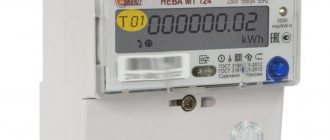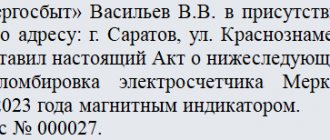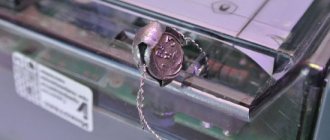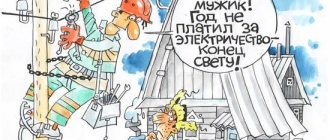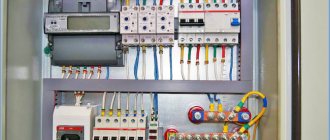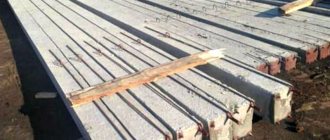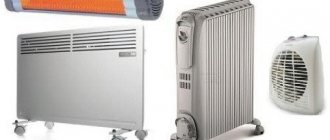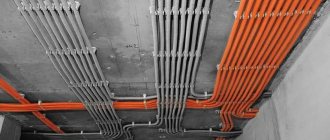There are various types of meters to record consumed electricity. Single-phase electricity meters are used in two-wire AC networks, where the standard voltage is 220 volts. They are ideal for apartments, cottages, offices, garages, etc. Electric three-phase meters perform the same functions, only the networks where they are installed are three- or four-wire. The current frequency in such networks is 50 Hz and the voltage is 380 V. They are used at industrial production facilities and other places with high electricity consumption.
In conversations, the concept of a two-phase electricity meter is often used. It should immediately be noted that such devices simply do not exist in nature. This term refers to a single-phase multi-tariff meter, which allows you to save on paying for consumed electricity.
What is a multi-tariff accounting system?
The amount of energy consumed depends on the time of day, which forces energy specialists to divide the day into several zones:
- NIGHT. Starts at 23.00 and ends at 7.00 am. Its peculiarity lies in the most favorable tariff.
- MORNING (PEAK). This zone starts at 7.00 and continues until 9.00. After rest, people wake up and get ready to go to work. They include many electrical appliances, which leads to a sharp increase in load. In addition, during this period the working day begins in companies and enterprises.
- DAY (HALF PEAK). This period covers a larger range from 10.00 am to 17.00 pm. The “lion’s” portion of people are at work, so the workload is approximately equalized. The largest consumption remains with companies, firms and organizations.
- EVENING (PEAK). In the period from 17.00 to 21.00, the second phase of the highest load takes place, when people return from work and turn on various sources of load, namely washing machines, electric kettles, air conditioners, PCs and other household appliances.
- EVENING (HALF PEAK). This zone is limited to two hours from 21.00 to 23.00. The period is characterized by a gradual decrease in load as people go to bed.
A multi-tariff meter is a special device for metering electricity that controls each of the mentioned periods. Thanks to this mode, the network is unloaded during peak hours due to the transfer of part of the power to the night or weekends.
The use of differential metering allows you to reduce costs, which is especially important for enterprises with a round-the-clock operating cycle or with short interruptions in the work of consumers.
Buying a multi-tariff meter is considered a profitable investment for manufacturers of various products. With this approach, it is possible to reduce the cost of goods and thereby increase profits.
To effectively use such devices, it is important to understand the intricacies of the operation of such meters and determine the relevance of their use.
As for apartments and houses, there are enough metering devices designed to work with two tariffs.
What is a two-tariff meter, how it works
The essence of a two-tariff meter is simple. Unlike a standard meter, it controls consumption in two zones - daytime (from 7.00 to 23.00) and night (from 23.00 to 7.00), which allows you to split the payment for electricity.
In the first case, the standard tariff applies, and at night it is significantly lower. If you plan to use powerful consumers at night, using a two-tariff meter is the way to save money.
The relevance of the transition to such devices is easy to explain. It is important for power plants and substations that the load on equipment is uniform throughout the day. In practice, it is higher in the morning, afternoon and evening hours than at night. As a result, equipment operates at its limit and breaks down faster.
The widespread use of two-tariff meters allows for load balancing, that is, transferring part of the load from peak hours to night time. As a result, fuel consumption is reduced and the service life of equipment at power plants increases.
Who benefits from it?
According to these calculations, we can conclude that the three-tariff system turned out to be the most profitable, since here the consumer can determine for himself in what period to turn on high-power devices and thereby save his budget. A two-tariff meter is also beneficial for those who do not intend to use electricity during certain phases. As for the single-phase meter, it is beneficial only to those consumers whose regional rates are significantly lower than on other systems. However, it is worth remembering that the payback period for a two- and three-tariff meter can take up to 5-6 years.
Wave load
If we consider electricity consumption at the “lower level”, the graph looks like a sinusoid. For example, in a building with a large number of apartments, people rest at night, and a small part of electrical appliances (refrigerator, PC, night light and other devices) are in operation.
Between 7 and 10 a.m. the situation changes and the load curve rises sharply. People get out of bed and start getting their children ready for school, getting ready for work and solving other problems. As a result, many electrical appliances turn on, from the TV to the electric kettle and boiler.
Then the residents go to work, and the load situation returns to normal - the curve goes down again and remains there until the evening, when people return from work and start doing household chores - swimming, watching TV, heating food in the microwave, cooking in the oven, and so on Further. As a result, the current consumption increases again and reaches peak values.
The maximum load occurs until 10-11 pm, after which people gradually go to sleep, and the cycle repeats. It's time for another overnight low. To avoid the fluctuations discussed above, two-tariff meters are being introduced. Their feature is load control in only two zones, namely at night and during the day.
Reducing tariffs at night and increasing them during the day encourages people to switch to new metering devices. As a result, both sides win.
The consumer saves electricity and receives payments with smaller amounts, and the electricity supplier relieves substations and power plants, thereby extending the life of expensive equipment. The risk of network failures due to peak loads is also reduced.
A person who has installed a two-tariff meter can turn on the machine, boiler and boiler at night, when the electricity tariff is lower, and turn them off in the morning.
Day-night tariff
The two-phase method of calculating electricity is otherwise called the day-night tariff. It operates in many regions of our country, but tariffs for the population vary. The differentiated regime is especially popular in the capital. It is beneficial to people who:
- actively use powerful electrical appliances, such as bread makers, boilers, dishwashers;
- equipped their apartments with warm floors or a convection heating system;
- have large country houses with an extensive lighting system, well or sewage pump, etc.
Time of night and day tariff
We have already discussed this issue above, but we will cover it in more detail.
Fixing a price for a specific zone helps with the following tasks:
- Reducing load during peak hours;
- Reducing energy consumption;
- Protection of the home electrical network from damage or tripping of protective equipment.
Many people have been in a situation where, due to the inclusion of a large number of receivers in the electrical panel, the machine is knocked out. The reason is excessive load that exceeds the permissible level. For this reason, the input to the house or even the switch at the substation may be turned off.
The transition to a night tariff is relevant for rural residents, who will be able to turn on the heating of their home, greenhouse, and other premises only in the dark. As a result, heating costs are reduced by 30-40%, and sometimes more.
As noted, the two-tariff meter operates in two zones - from 23.00 to 7.00 (night) and from 7.00 to 23.00 (day). However, the night range may vary depending on the number of zones:
- Between 11 am and 7 am. With a two-zone tariff, electricity costs are reduced by 30% for ordinary consumers (individuals) and by 40% for companies (legal entities).
- Between 11 am and 6 am. If a three-tariff meter is used, the payment is even lower. In this case, the payment for night use is 35% of the regular rate (for ordinary citizens) and 40% for companies.
Calculation of the benefits of a two-tariff flow meter
Benefit is a flexible concept. It must be determined by everyone for themselves, depending on the characteristics of the operation of certain household appliances. For ease of calculations, you can use standard indicators of electricity consumption for home devices.
The most powerful household appliances include:
- refrigerator (consumes approximately 30 kW per month depending on the model);
- washing machine (30-35 kW);
- personal computer (36-40 kW, but the figures can be 2 times higher if we are talking about a powerful PC);
- electric kettle (approximately 25 kW per month, although during 1 hour of operation this device consumes an extremely large amount of energy);
- hair dryer (5-15 kW);
- dishwasher (20-22 kW per month when used about 3 hours per week);
- microwave (10-13 kW);
- TV (5-12 kW);
- vacuum cleaner (5-10 kW);
- iron (around 7-8 kW).
Now, based on the consumption of each device, you need to check how much you will have to pay for light with a single-tariff and two-tariff meter.
All calculations are carried out taking into account electricity tariffs in Moscow and the Moscow region. In the Moscow region, for a single-tariff meter, the cost of 1 kW is 5.47 rubles.
For two-tariff electricity meters, prices are slightly different. When using a differentiated tariff at night (from 23 to 7 o'clock) a fee of 2.13 rubles per kilowatt will be charged, and during the day - 6.29 rubles per kW. In other regions, the cost per kilowatt may differ, but the proportion itself will remain the same.
The cost of a kilowatt depends on the geographical features of the region: for example, Chukotka and Kamchatka have the highest electricity tariffs in Russia
When calculating the financial benefits of a two-tariff electric meter, you need to take into account the time at which the specified household appliances usually operate. This will make it possible to carry out correct calculations.
The operating time of each household electrical appliance looks something like this:
- The refrigerator operates 24 hours a day.
- The washing machine can be started after 23:00, but at night you can wash it a maximum of 2 times (and usually once), because the washing cycle is 1-2 hours, depending on the program used.
- The computer is used both day and night, depending on the schedule of life and the nature of work.
- The electric kettle is turned on in the morning (including before 7:00), and in the evening, when they come home from work (before 23:00), and after 23:00. But mostly the kettle is boiled between 18:00 and midnight.
- Hair is often dried with a hairdryer after 7 am, when electricity is calculated at the daily rate.
- The dishwasher with the dirty dishes accumulated during the day can be turned on after 23:00.
- Food is heated in the microwave mainly from 7 to 23 hours.
- TV is watched in the evening on weekdays, so it often works during the night tariff.
- Due to the noticeable noise (if you do not take into account some modern models), the vacuum cleaner is practically not turned on early in the morning (before 7:00) or late in the evening (after 23:00).
- You can iron things with an iron even during the night tariff (after 23:00).
Now you can do some small calculations. For examples, we take information about the average electricity consumption of household appliances per month.
For a single-tariff electric meter, the calculations will be simple. First, the total consumption of all devices is calculated based on averaged data. It is equal to 173 kW. Without any devices (for example, a dishwasher, vacuum cleaner or electric kettle), this value may be lower. On a single-tariff meter, for 173 kilowatts according to Moscow tariffs you need to pay 993 rubles.
We also recommend that you familiarize yourself with the best methods for transferring data to your account.
Before installing any electrical appliance in an apartment, you must first evaluate its energy efficiency, and then buy it
Before calculating the benefits of installing a two-tariff meter, you should analyze the actual electricity consumption in the apartment and determine the devices that are constantly working.
The calculations are a little more complicated, so it would be more appropriate to calculate the cost of consumed electricity separately for each device, and then add up the information obtained:
- The refrigerator works both at night and during the day, so you need to calculate one half of its operating time according to the daytime rate, and the other half - according to the night rate. The example looks like this: 15*2.13+15*6.29=126 (rub.).
- A washing machine can be used in a similar way, but here it is better to use a ratio of 1 to 3, i.e. according to the night tariff, you should calculate only a third of the total consumption: 10 * 2.13 + 20 * 6.29 = 147.1 (rub.).
- Calculation for a computer : 18*2.13+18*6.29=153.69 (rub.).
- For an electric kettle, approximate calculation: 13*6.29+12*2.13=107.33 (rub.).
- The hairdryer is rarely turned on before 7 am and after 11 pm, so it is better to take into account only the daily rate: 5 * 6.29 = 31.45 (rub.).
- The dishwasher can be turned on at any time, but let’s assume that it is set on a timer after 11 pm: 20 * 2.13 = 42.6 (rub).
- Calculation for a microwave : 10*6.29=62.9 (rub.).
- For TV : 3*2.13+2*6.29=18.97 (rub.).
- For a vacuum cleaner : 5*6.29=31.45 (rub.).
- For iron : 7*6.29=44.03 (rub.).
If you add up all these values, you get 765.5 rubles. This is almost 230 rubles less than the amount that you will have to pay for the consumption of household appliances when using a single-tariff meter. But this is subject to loading the dishwasher late in the evening and periodically washing at night.
If there is no dishwasher (and not every family has one), then the difference in readings will be less: 722 rubles for a two-tariff meter versus 880 rubles for a single-tariff meter. Those. the overpayment in the second case will be about 160 rubles.
Savings and convenience rarely go hand in hand, so when installing a two-tariff meter you need to be prepared for the fact that you will have to turn on the dishwasher or washing machine at an inappropriate time
Then you need to calculate how much electricity all the light bulbs in the house consume. They are found in chandeliers, floor lamps, sconces and other lighting fixtures.
The number of kilowatts depends on the type of lamp:
- LED light bulbs consume 10 watts per hour;
- fluorescent - 36 watts per hour;
- incandescent lamps - 96 watts per hour.
The lights are turned on at night. In winter, it starts to get dark at 16:00, but a lot depends on the region. On average, each light bulb in the house works about 4 hours a day (some less, some more). Those. per month, one LED lamp consumes 1.2 kW, a fluorescent lamp consumes 4.3 kW, and a regular lamp consumes 11.5 kW.
LED light bulbs are expensive and are not sold in all stores, but they can significantly save on monthly electricity bills
The number of light bulbs in apartments depends on the personal preferences of its owners and the total area of the room. For example, in a two-room apartment there can be either 5 or 25. But for calculations, you can take an approximate value of 15 lamps: 3 in the kitchen and both rooms, two in the hallway and bathroom, and one in the pantry and toilet.
If all the light bulbs in the apartment are LED, 18 kW will accumulate in a month, if they are fluorescent - 64 kW, and if they are regular - 172.5 kW.
The more lamps, floor lamps and sconces in an apartment, the brighter and more comfortable it is, and therefore you should not skimp on lighting fixtures
If a regular single-tariff meter is installed in the apartment, then you will need to pay 98.5 rubles per month for LED bulbs, 350 rubles for fluorescent bulbs and 943.5 rubles for regular bulbs.
If you use a two-tariff meter, your electricity bill will be reduced. However, the lights often turn on before 11 p.m., so the bulbs will still work during the daytime tariff. The ratio can be taken as 1 to 3.
The cost of a month of electricity consumption is equal to:
- for LED light bulbs: 6*2.13+12*6.29=88.26 (RUB);
- for fluorescent: 22*2.13+42*6.29=311.04 (rub.);
- for incandescent lamps: 57.5*2.13+115*6.29=845.83 (rub.).
The benefit depends on the type of light bulbs installed. For LEDs it will be about 10 rubles, but for incandescent lamps – already 100 rubles. But does it make sense to buy a two-tariff flow meter if you can replace the light bulbs in the house with more economical ones?
Current tariffs (using the example of Moscow and the Moscow region)
The amount of payment for electricity for two-tariff meters depends on three factors - the type of slabs in a multi-storey building, the time of day, month of the year, and the region. Let's look at the main options.
Multi-storey buildings with apartments with gas stoves
- In the period from January 1 to June 30, the night and day zone tariffs for Moscow are 1.79 and 6.19 rubles, and for New Moscow - 2.24 and 6.03 rubles, respectively.
- In the period from July 1 to the end of 2022, the following tariffs apply at night and daytime: 1.92 and 6.19 for Moscow and 2.41 and 6.19 for New Moscow.
Multi-storey buildings with electric stoves
- From January 1 to June 30, the night and day zone tariffs for Moscow are 1.26 and 4.65 rubles, and for New Moscow - 1.58 and 4.41 rubles, respectively.
- From July 1 until the end of 2022, the following tariffs apply at night and during the day: 1.35 and 4.95 rubles for Moscow and 1.7 and 4.74 rubles for New Moscow.
Apartments and houses located in rural areas
- From January 1 to June 30, the night and day zone tariffs are 1.58 and 4.22 rubles, respectively.
- From July 1 until the end of 2022, the following tariffs apply at night and during the day: 1.7 and 4.34 rubles.
Two-tariff electricity meter table
Full version of tariffs for 2022.
See all changes in tariffs for the next years on the website https://mosenergosbyt.info/tarify/.
Calculation of savings in houses with installed electric stoves
Residents of high-rise buildings do not have gas supply, since the pressure in gas pipes can only reach 10 floors. According to the plan, apartments in such houses are equipped exclusively with electric stoves.
In houses equipped with stationary electric stoves and electric heating installations, the electricity tariff is significantly lower.
Before leaving a single-tariff meter or installing a two-tariff meter, you need to understand whether this is beneficial in terms of electrifying the entire house, take this fact into account and carry out the calculation.
As an example for the calculation, we took the cost of the tariff rate for residents living in houses with installed stationary electric stoves and electric heating installations for the first half of 2022 in the Lipetsk region.
Single-rate tariff - 2.57 rubles. per kW/h.
Two-zone tariff:
- day - 2.96 rub. per kW/h;
- night — 1.54 rub. per kW/h.
Estimated consumption in winter is 300 kW per month. Single-rate tariff - 2.57 per kW/h. Thus, with a single-tariff meter, the consumer will pay for the services of energy sales companies: 300 × 2.57 = 771.00 rubles.
Consumption in winter is also 300 kW per month, but 100 kW is during the day and 200 kW at night. The volume of kilowatts is calculated at a tariff differentiated between two zones. Day – 100×2.96=296.00 rub., night – 200×1.54=308.00 rub. The total amount for a two-tariff meter per month will be 604.00 rubles.
Calculation of the difference and determination of savings: 771.00−604.00=167.00 rub. per month, and per year - 167.00 × 12 = 2004.00 rubles.
The savings are slightly lower than in houses with gasification, but over time, for example, over a year it still turns out to be quite a significant amount. In houses with built-in electric stoves, the consumer himself chooses the optimal metering tariff for him and whether the electric meter needs to be replaced.
How do you pay?
To make a payment you will need a receipt with the accrued amount for the light, a calculator and a pen.
The algorithm of actions is as follows:
- We take readings from a two-tariff meter for the day and night shifts.
- We take the old receipt, according to which payment was made for the last month, and subtract the previous parameters in the section “On the day of payment” from the figure of the new readings. We multiply the resulting number by the tariff that is valid in the city (region) of residence.
- We subtract from the number of “night” readings the data that is recorded in the old receipt in the column “On the day of payment”. We multiply the resulting number by the tariff that applies to the night zone.
- Sum up the received figures for the day and night, after which we make a payment taking into account the result obtained at the nearest bank branch or in another way (for example, at a Russian Post office).
Advantages and disadvantages of two-tariff meters
When connecting a two-tariff meter, it is important to consider the pros and cons of such a transition. Let's take a closer look at them.
Advantages:
- For the consumer - a reduction in electricity costs by an average of 30-40%. This is due to the lower cost of electricity at night.
- For energy supply organizations - uniform distribution of load within 24 hours, which reduces overload during peak hours and helps to increase the service life of equipment.
- For the environment - reducing the volume of harmful emissions due to the uniform operation of the power plant.
- For enterprises, it saves energy at night, which helps reduce costs and production costs.
Flaws:
- Electrical appliances are left on at night, resulting in increased noise levels.
- Two-tariff meters are expensive and, according to users, often fail.
Installation nuances and connection diagram
To prevent damage to the electric meter from illegal actions of third parties or aggressive environments, a protective casing or shield is provided. However, when installing an electricity meter in a protective casing or shield in accordance with clause 5.3 of GOST 31818.11-2012, it is necessary to provide a transparent window to allow readings to be taken.
Rice. 2. An example of a window for taking readings on the casing of an electric meter
An important nuance when installing a two-tariff electricity meter is the need to coordinate the replacement with the management company. The electricity consumer must first submit an appropriate application to transfer the metering point to a two-tariff mode. If such an opportunity exists and there are no debts at your address, then the contract department will issue a receipt for payment for services for the dismantling of the old electricity meter, installation and commissioning of a two-tariff electricity meter.
In accordance with clause 1.5.27 of the PUE, electricity meters must be installed inside dry heated rooms. Therefore, you can always counter the demands of the electricity supply organization to move the electricity meter outside the premises. However, please note that if the electricity meter is located in the house, you will have to provide unhindered access to the metering point for company representatives.
To connect a two-tariff electricity meter to a single-phase network, you must use the diagram shown in the figure below:
Rice. 3. Connection diagram for a single-phase two-tariff electricity meter
To do this, you need to connect phase conductor L from the supply line to terminal 1 of a two-tariff electricity meter, and connect phase conductor from terminal 2 to the load. The neutral conductor N is connected similarly to terminal 3 of a two-tariff electricity meter, and from terminal 4 to the internal distribution circuit and household electrical appliances. This is the most common option for most household consumers powered by a single-phase circuit. The connection method and marking of the terminals may differ depending on the specific model of the two-tariff electric meter, so you need to take into account the individual connection diagram.
For enterprises or a separate segment of household consumers, three-phase power supply schemes can be used. In which it is advisable to install a three-phase two-tariff electricity meter.
Rice. 4. Connection diagram for a three-phase two-tariff electricity meter
A three-phase electricity meter is connected in a similar way; each of the phase conductors L1, L2, L3 is connected in turn to the terminals of the electric meter, and from the same terminals they are connected to the load. The neutral conductor N is also connected to the electric meter and from the terminal to the load. To protect the electricity meter itself, an input circuit breaker is installed, after which circuit breakers, UDTs and other protective devices can be used.
Read more information about connecting electricity meters in the article:
When is installing a two-tariff meter beneficial?
To determine the relevance of installing a two-tariff meter, it is important to take into account a number of parameters - the presence of powerful equipment in the house or apartment, as well as the electricity tariff in the region.
To calculate efficiency, a number of steps are required. First, let's find out the price of 1 kW for a standard and two-tariff meter. After this, the amount of energy consumed at night is measured.
Once the declared parameters are in front of your eyes, you can substitute them into the following formula:
Mon = 100 x (Td - T1)/(Td - Tn), where:
- Mon—energy consumption at night;
- Тд — price of the daily tariff;
- Тн — cost of the night tariff;
- T1 – the price of a 24-hour tariff (on the meter this is a day zone, do not confuse it).
The final result is given as a percentage. For example, if it turns out to be 30%, this means that to get the effect you will have to increase the level of consumption at night by 30%. Only with this approach can we talk about the relevance of the new two-tariff meter.
If consumption at night is higher than the calculated parameter, this is only a plus.
Let's look at an example. We take the numbers from the photo below.
We get (6.19-5.38/6.19-1.92) x 100 = 18.9%.
How to choose a two-tariff meter?
Before purchasing a meter that records the amount of energy consumed in two different zones, it is important to study market offers and understand the nuances of such devices. Below are recommendations that will help you avoid making mistakes with your purchase.
What to look for when choosing?
Before buying a device, it is worth checking with your local energy supply organization about the possibility of installing such a meter and the availability of tariff divisions. It is important to remember that a multi-tariff device will cost more, so its installation should pay for itself. Otherwise, there is no point in installing the device.
It is also worth finding out the number of tariff levels, which can be 2 or more. A number of modern two-tariff meters have a large reserve and allow you to program up to eight or more modes.
Principle of operation
The electricity metering devices under consideration are divided into two types (according to the principle of operation):
- Electronic;
- Induction.
The latter are an outdated version of the device that was previously installed in all homes. The device consists of a coil that creates an EM field that rotates the disk.
Electronic devices are built on a semiconductor circuit that converts current into pulses. The latter are recorded by a counting device. Electronic metering devices are conventionally divided by the type of indication - it can be electromechanical or digital (the numbers are reflected on a special display).
It is logical to assume that multi-tariff devices can only be electronic and with digital display of indicators on a special screen. By the way, this feature makes a number of adjustments to the installation location. Such displays are afraid of direct sunlight and low temperatures. Under such conditions, the display may not display information at all.
That is why the device should be mounted in a special heated cabinet and away from sunlight.
Accuracy class
Based on this indicator, one can judge the maximum error of the device. This parameter is reflected as a percentage. If induction meters had a class of 2.5, new devices operating on a semiconductor base are more accurate - up to 0.5.
To find out this parameter, you should look at the technical documentation of the device or look at the device itself. The accuracy class is indicated as a number “hidden” in a circle.
The lower the number, the more accurate the device. When choosing, it is worth considering that for private houses an accuracy class of 2 and higher is allowed. As for class 1.0, it is mandatory for the input of buildings whose power is more than 0.67 MW.
In addition, according to the law, even with a low accuracy class, no one has the right to force the meter to be changed. This is done only at the end of the inter-inspection period or in the event of a product breakdown.
If employees of an electricity supply organization demand that the old device be replaced and a two-tariff meter with class 1.0 be installed, such actions are illegal.
Currents (single-phase, maximum, three-phase)
Most apartments in populated areas are connected to a single-phase 220V network with a frequency of 50 Hz. This means that when choosing a metering device, it is important to focus on this indicator.
But there are exceptions to this rule. In some houses where there are electric stoves, a three-phase network with a voltage of 380 Volts is supplied.
You can recognize a 3-phase network by the special type of plugs and sockets. Under such circumstances, you will have to buy an appropriate device connected to three phases.
Another important nuance is the maximum load current (maximum and minimum). Most devices are designed to carry a current of 60 A, which is enough for a house or apartment.
If calculations show that the total power of electrical consumers is more than 10 kW, it is recommended to take a meter with a maximum current of 100 A.
The peculiarity of such devices is that they are connected directly and without the use of additional converters. If the load exceeds 100 A, you will have to connect additional equipment (current transformer).
To find out the voltage and current parameters discussed above (min and max), just look at the technical data sheet of the device or look at the front panel.
What else to consider when choosing?
When studying the models available on the market, it is important to pay attention to additional functions. For example, many devices provide communication via GSM with the transfer of information to local stations.
In addition, devices are sold that control other types of resources, including gas and water.
Additional options also include:
- Entering electricity consumption parameters by month;
- Taking instantaneous parameters of current, power and other parameters and reflecting them in the log;
- Other functions.
Classification of electricity meters
Electricity metering devices differ in the number of tariff zones. Their difference is that they are divided into single-tariff and multi-tariff.
A single-tariff meter records the consumption of electrical energy around the clock at one tariff.
In turn, multi-tariff electricity meters are divided into subtypes:
- accounting for two zones (two tariffs): day (peak) zone T1 and night T2;
- accounting for three zones (three tariffs): peak zone T1, half-peak zone T2 and night T3;
- metering in four zones (four tariffs): designed for metering electricity of large enterprises.
A multi-tariff meter records the volume of electricity at a certain time of day (zones). In Russia, no more than three tariffs are accounted for.
Popular models
Today, three models of two-tariff meters are most in demand on the market - MZIP, Energomera and Mercury. Let's take a closer look at them.
Mercury
Mercury meters are produced by , which produces a wide range of metering devices - from conventional 1-phase devices to more complex 3-phase models.
The products are manufactured at a high technical and scientific level, which makes NPK Incotex one of the best companies today.
Now the company produces other products - cash registers, automated accounting and control systems, various types of screens and displays, POS and other equipment.
Popular multi-tariff meters include the following Mercury models:
- Three-phase - 256 ART, 234 ARM (2), 230 ART, 231 AT, 231 ART Sh.
- Single-phase - 206, 203.2T, 201.8 TLO, 200.
Official website of the company https://www.incotexcom.ru/.
Energy meter
The Energomera company positions itself as the Russian market leader in the production of metering devices. Every year, more than 3 million metering devices are produced at the enterprise's factories. Moreover, over 20 years of operation, more than 30 million devices have been produced.
The company includes 4 factories and 1 institute. In addition to two-tariff meters, the company produces ASKUE systems, low-voltage equipment, metrological and switchboard equipment, devices for electrochemical protection and other equipment.
Popular models of multi-tariff meters include:
- Single-phase - CE 102-R5.1, CE 102M-R5, CE 102-S7, CE 102M-S7, CE 201-S7.
- Three-phase - CE 307-R33, CE 301-R33, CE 307-S31, CE 303-R33, CE 303-S31.
Official website of the company https://www.energomera.ru/.
MZEP
At the moment, the Moscow MZEP plant is considered one of the best in the field of manufacturing metering devices. Every month, the plant produces more than 100,000 devices, which are used both in private homes and in large organizations.
The company's products are certified and meet internationally accepted quality standards. Before sale, the plant's two-tariff meters are tested by the metrological service, and their compliance with the requirements is confirmed by certificates.
Popular multi-tariff models of the manufacturer:
- Single-phase - AGAT 2-12, AGAT 2-23M, AGAT 2-23M1, AGAT 2-27M, AGAT 2-42.
- Three-phase - AGAT 3-1.100.2, AGAT 3-1.5.2, AGAT 3-1.50.2, AGAT 3-3.100.5, AGAT 3-3.60.2.
Official website of the company https://mzep.ru/.
Choosing a device: what to look for?
Before purchasing, decide whether a multi-tariff model is beneficial for you or whether you should stay with a single-rate tariff. If yes, then when choosing a device, follow our advice:
- Manufacturer. At the moment, the Russian market is based on three pillars - meters - 37%, Incotest - 31%, Taipit - 17%. Other manufacturers account for 15% of the market;
- Certificate. When purchasing a foreign-made meter, pay attention to its presence in the State Register list;
- Completeness. Clear factory serial numbers, the presence of seals, quality control of the product - everything must be present.
You should also pay attention to the accuracy class of the device, the warranty period and the calibration interval of the meter.
Installing a meter that works with the “day” and “night” tariff zones is not advisable for every family. If the apartment has a boiler or electric heating, and the owners lead a nocturnal lifestyle, then such a device is economically justified. In any other case, the payback of the meter will last more than one half year, and the benefits from using such a device will be minimal.

